CSotD: A Frank Analysis
Skip to comments“In spite of everything I still believe that people are really good at heart. I simply can’t build up my hopes on a foundation consisting of confusion, misery, and death. I see the world gradually being turned into a wilderness, I hear the ever approaching thunder, which will destroy us too, I can feel the sufferings of millions and yet, if I look up into the heavens, I think that it will all come right, that this cruelty too will end, and that peace and tranquility will return again.” – Anne Frank

Anne Frank was young and, despite all that she had seen and experienced, retained the optimism and idealism of youth.
Pedro X. Molina is older, and has seen and experienced much which has made him less starry-eyed than Anne Frank, but the fact that he was willing to flee Nicaragua and keep on keepin’ on with his cartooning suggests that he hasn’t lost his idealism and optimism, either.
It’s easy to point out that Anne Frank died of typhus in Bergen Belsen, shortly before the concentration camp was liberated by British forces, as if that negates the value of her optimism.
But if so, then there was also no value in the optimistic fight others put up, including those British soldiers as well as the homefront.
It’s also easy to pretend that what happened in Europe in the 1930s began with the rounding up of Jews, Poles, LBGTQ+ people and Roma, but of course it didn’t. It began earlier, and by the time the concentration camps were being filled, it had become perfectly normal.
Too few people spoke up when Jews were first being blamed for problems in the economy and in society. Noone said they were eating cats and dogs, but we shouldn’t get hung up in the details, and Trump has indeed brought in the Jews.
Molina is not exaggerating when he connects what we are hearing and what was said in those days before the darkness had fully descended.

John Cole points out, too, that what we are hearing is not new, and has been said by American hatemongers before.
What is new, rather, is that those vicious people were, in the past, relegated to the sidelines, dismissed as crazies by “the decent people.”
And yet the generation that had fought against the Nazis, and against Japanese imperialism, also faced the Red Scare of McCarthyism, and got to see the open casket of Emmett Till.
Neither VE or VJ Day had ended their need for vigilance and resistance, and, in fact, the seeds of the Civil Rights struggle were planted in World War II, when Black soldiers and civilians were determined not to repeat the rash of lynchings that had greeted the veterans of WWI, and when many of their white fellow veterans, having finally met the people they were separated from by Jim Crow, agreed that time had come.
And yet here we are again.
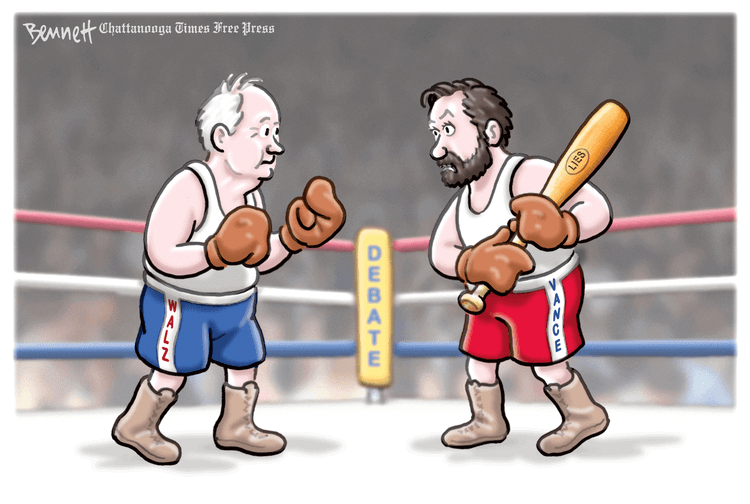
Clay Bennett (CTFP) looks ahead to tonight’s vice-presidential debate, suggesting that Tim Walz will fight fairly while JD Vance comes at him with lies. And while neither will wear boxing gloves and Vance won’t bring a baseball bat to the meeting, there’s little exaggeration in the accusation itself.
The lies that Vance and Trump have spread about immigrants are blatant and have been easily and properly disproven, and yet they continue to spout them and a certain segment of the population continues to believe them.
How large a segment? We’ll find out November 5.
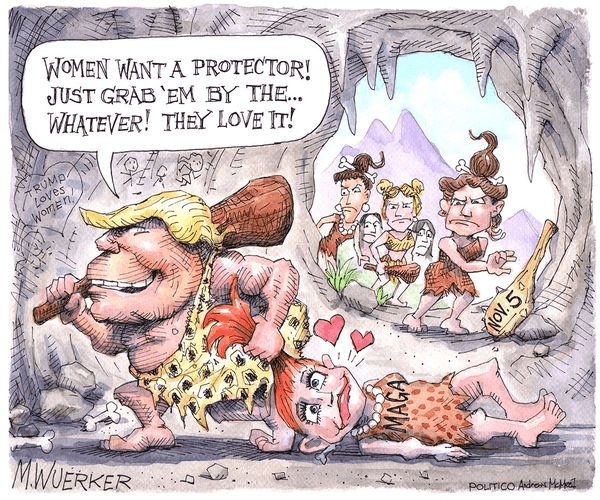
Cartoonists have had a holiday with Trump’s promise to be the protector of women as he brags over his part in taking away their right to determine their own health care, and I hope Matt Wuerker (Politico) is correct in depicting the proportion of women who believe misogyny is love and those who recognize it as abuse.
The old cartoon cliche of cavemen dragging women away by their hair does not fit any hunter-gatherer society I have ever examined. In most native communities, women have a substantial role not only in overseeing marriage and other domestic arrangements, but in governing of society overall. Iroquois society remains matriarchal today, while women wield great authority in nearly every native culture.
Cultures in which women are subjected, it seems, include those generally considered “advanced.”
We’ll test that viewpoint in a month.
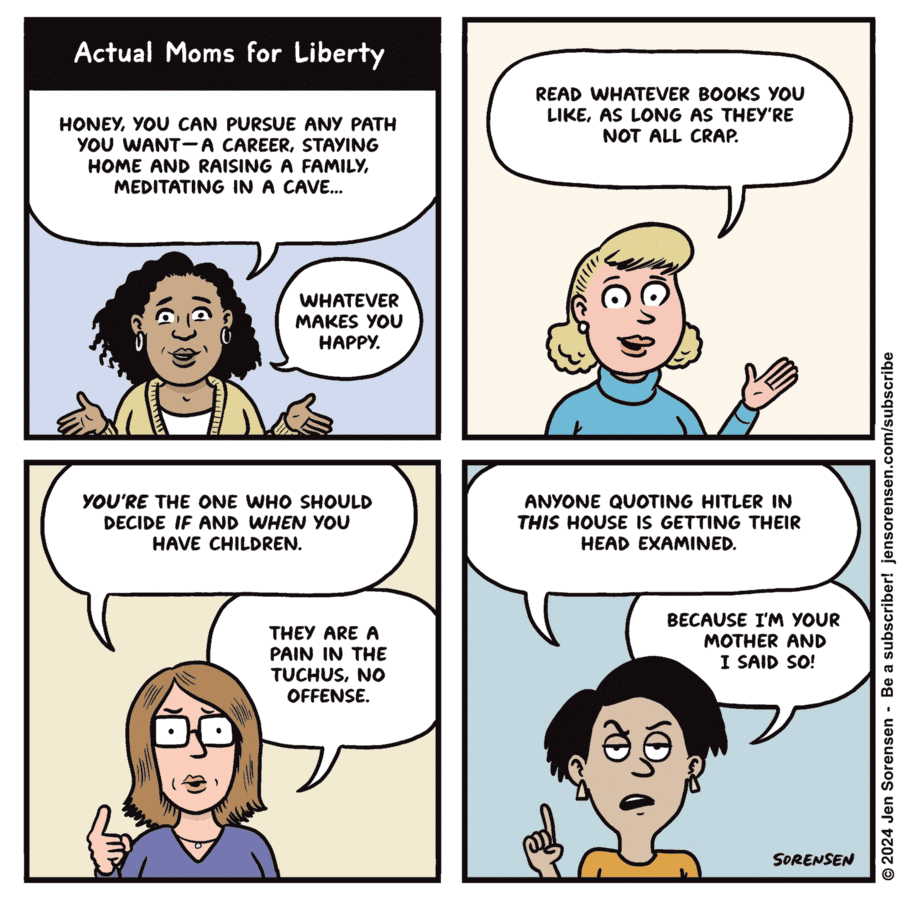
Jen Sorensen has her view of how women should exercise liberty, despite the conservative women’s groups that seem to work against the concept.
It should be remembered that, throughout the women’s movement, there have always been women who opposed it.

The Suffrage Movement was greatly helped by women who turned out, as these women did in NYC in 1915, to show the strength of their numbers.
It’s an issue of democracy: If women don’t want to press for greater autonomy, they can vote for those who would restrict it. One of the arguments against women’s suffrage was that it gave husbands two votes instead of one. In some families, it did.
We shall test that on November 5 as well. It’s a mistake to assume women will universally reject Trump and Vance.
While Biden defeated Trump in 2020, white women did not provide the edge:
Among white women, according to NBC News, 43 percent supported Biden and 55 percent supported Trump. About 91 percent of Black women supported the former vice president and 8 percent supported Trump. Roughly 70 percent of Latina women supported Biden and 28 percent supported the outgoing president.
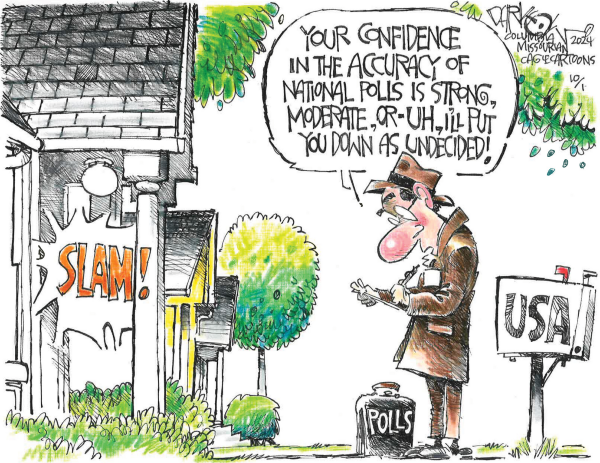
John Darkow suggests that we shouldn’t pay too much attention to the polls, and their record in recent years has been spotty at best.
Some people suggest that pollsters no longer reach a cross-section of the population, that many younger and more middleclass voters either hang up on them or decline to answer calls from unknown numbers.
Other, more insider critics question the way polls are weighted to compensate for any lack of demographic balance.
And there’s always the question of whether having a candidate in the lead adds to the bandwagon effect and encourages voters, or makes them think the race is won and they don’t need to show up on Election Day.
Most polls are currently close. Perhaps they’re right, perhaps they’re wrong.
But the only count that matters will be on November 5.
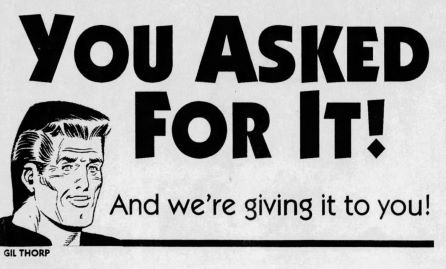
Comments 2
Comments are closed.